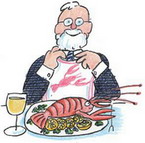![]()

Vegan Cassoulet
In 2001 I served cassoulet to a mixed table of carnivores and vegetarians. For the latter, I came up with the following, which I wrote down a few days later:
A vegan cassoulet? It sounds about as appealing as a no-alcohol martini. But don’t jump to conclusions. This dish is not for weight-watchers, nor is it a time-saving instant stir-fry. Rather, it calls for a bit of effort and experimentation, whereby you can summon up the smooth opulent multi-flavored richness of a veritable Toulouse cassoulet, with its blending of goose or duck, pork and/or lamb and sausage on a foundation of beans, held together with a liberal infusion of animal fats. This vegan version, together with the real thing, was recently served to a mixed company of vegetarians and carnivores. The latter, attempting to decide which they preferred, kept passing their plates.
Charles Shere has suggested that the “significant variable” in the making of a fine cassoulet might be the shape of the pot in which it is baked. The authentic cassole, the “squashed flower pot” still produced by the Not family in Languedoc, is difficult to obtain without a pilgrimage to Mas-Saintes-Puelle. Fortunately, its proportions and graduated sizes are very similar to old-fashioned pottery mixing bowls – white on the inside, cream on the outside, and decorated only by an exterior molded design. Everyone’s grandmother had a nested set of them and they’re still available in kitchenware shops.
A couple of pounds of dried haricot beans, together with the other ingredients, are enough to fill the largest size mixing bowl, about thirteen inches across at the top. The beans should be soaked overnight and the water discarded, then simmered slowly in fresh unsalted water until easily chewed but not spontaneously breaking up. Over a very low flame this can take up to two hours. After the first hour check them every few minutes; they can turn quickly from al dente to mushy. Drain them, saving the liquid.
An assorted couple of pounds or more of roasted vegetables will provide the requisite richness and variety. (Any sensible variations in selection, quantity or proportion will alter the flavor of the dish but not spoil it.) Longer-cooking vegetables such as sweet potatoes, carrots, swedes, turnips, fennel, celery and onions can be roasted together. They should be peeled if necessary and cut into rough bite-size chunks. The slight variations in cooking times can be accommodated by varying the size; e.g., smaller for carrots, larger for sweet potatoes.
Spread them out in a single layer on a roasting pan, drizzle with enough olive oil to coat lightly, and stir them up with a little salt and pepper. Add a few peeled and split garlic cloves and herbs to taste, such as a couple of sprigs of fresh thyme and rosemary and a bay leaf or two. Roast in a medium oven, loosely covered with foil so as not to dry out, and finish uncovered to take on a bit of color. This will take an hour or more.
While the first tray is cooking, prepare another of chopped vegetables which require a shorter cooking time, such as sweet peppers, parsnips and aubergines. This tray, also covered until beginning to soften, can be put onto a lower shelf and the two trays reversed occasionally to equalize cooking time.
Soak a handful of sun-dried tomatoes in freshly boiled water for a few minutes until soft. Drain, saving the water, and chop coarsely.
Then prepare the stock. In a large saucepan heat a pint or so of the bean water and sun dried tomato water, together with a can of tomatoes or a small bottle of tomato concentrate, a generous quantity of mashed roasted garlic, and a hearty glug of olive oil. Bring to the boil and break up the solid bits with a potato masher. Boil vigorously for a couple of minutes to emulsify.
Mix all the cooked vegetables together, except the beans. Put a layer of beans into the pot, then all the roasted vegetables, and finish off with the rest of the beans. Add the hot stock carefully, allowing it to settle as you pour. Top up if necessary with more of the bean cooking water, stopping when the level is about a half-inch below the surface of the beans.
Finally, cover the top with a good layer of bread crumbs. (Crusts from a loaf of Poilane sourdough were designed by God for this very purpose.) Drizzle with olive oil; it may be possible to use too much, but I doubt it.
Bake the pot in a hot oven until the crust is brown and crisp. (The ingredients are already cooked, so you are only combining their flavors.)
If you are a person who thinks ahead, all this will have been accomplished at least a day before you intend to eat it. Unlike warmed-over ideas, art or romance, reheated cassoulet of whatever description gets better and better.
___________
You can add a handful of pitted olives; this gets further away from “authenticity”, but what’s authentic about an invented dish? You can even mix a hearty red wine with the cooking stock, never a feature of traditional cassoulet recipes. Carnivores may use chicken stock and add chunks of various cooked meats.
But all such variations will bring the dish closer to other existing recipes. There’s a certain shrewdness in John Cage’s observation that he didn’t care for improvisation because it was too predictable.